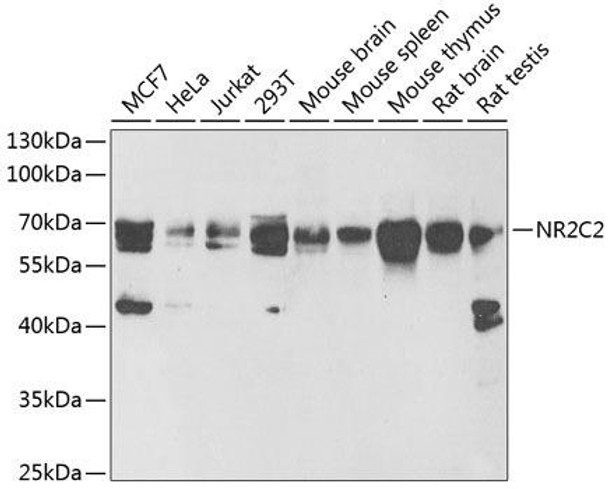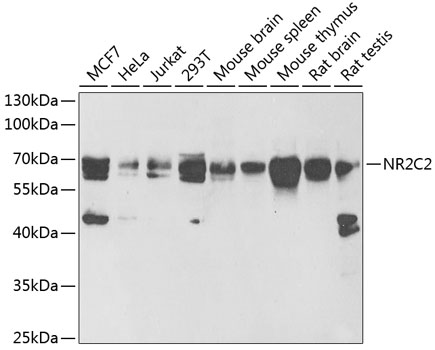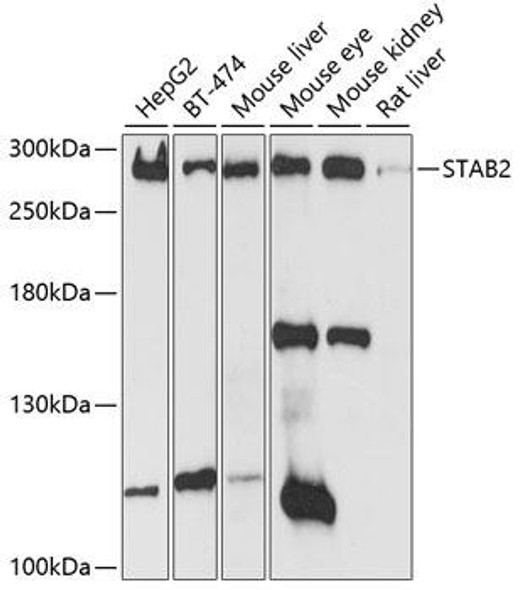Anti-NR2C2 Antibody (CAB6422)
- SKU:
- CAB6422
- Product type:
- Antibody
- Reactivity:
- Human
- Mouse
- Rat
- Host Species:
- Rabbit
- Isotype:
- IgG
- Antibody Type:
- Polyclonal Antibody
- Research Area:
- Developmental Biology
Frequently bought together:
Description
| Antibody Name: | Anti-NR2C2 Antibody |
| Antibody SKU: | CAB6422 |
| Antibody Size: | 20uL, 50uL, 100uL |
| Application: | WB |
| Reactivity: | Human, Mouse, Rat |
| Host Species: | Rabbit |
| Immunogen: | Recombinant fusion protein containing a sequence corresponding to amino acids 240-380 of human NR2C2 (NP_003289.2). |
| Application: | WB |
| Recommended Dilution: | WB 1:500 - 1:2000 |
| Reactivity: | Human, Mouse, Rat |
| Positive Samples: | MCF7, HeLa, Jurkat, 293T, Mouse brain, Mouse spleen, Mouse thymus, Rat brain, Rat testis |
| Immunogen: | Recombinant fusion protein containing a sequence corresponding to amino acids 240-380 of human NR2C2 (NP_003289.2). |
| Purification Method: | Affinity purification |
| Storage Buffer: | Store at -20°C. Avoid freeze / thaw cycles. Buffer: PBS with 0.02% sodium azide, 50% glycerol, pH7.3. |
| Isotype: | IgG |
| Sequence: | LIAT PTFV ADKD GARQ TGLL DPGM LVNI QQPL IRED GTVL LATD SKAE TSQG ALGT LANV VTSL ANLS ESLN NGDT SEIQ PEDQ SASE ITRA FDTL AKAL NTTD SSSS PSLA DGID TSGG GSIH VISR DQST PIIE VEGP L |
| Gene ID: | 7182 |
| Uniprot: | P49116 |
| Cellular Location: | Nucleus |
| Calculated MW: | 65kDa/67kDa |
| Observed MW: | 65kDa |
| Synonyms: | NR2C2, TAK1, TR4 |
| Background: | This gene encodes a protein that belongs to the nuclear hormone receptor family. Members of this family act as ligand-activated transcription factors and function in many biological processes such as development, cellular differentiation and homeostasis. The activated receptor/ligand complex is translocated to the nucleus where it binds to hormone response elements of target genes. The protein encoded by this gene plays a role in protecting cells from oxidative stress and damage induced by ionizing radiation. The lack of a similar gene in mouse results in growth retardation, severe spinal curvature, subfertility, premature aging, and prostatic intraepithelial neoplasia (PIN) development. Alternative splicing results in multiple transcript variants encoding different isoforms. |
| UniProt Protein Function: | NR2C2: Orphan nuclear receptor that can act as a repressor or activator of transcription. An important repressor of nuclear recptor signaling pathways such as retinoic acid receptor, retinoid X, vitamin D3 receptor, thyroid hormone receptor and estrogen receptor pathways. May regulate gene expression during the late phase of spermatogenesis. Together with NR2C1, forms the core of the DRED (direct repeat erythroid-definitive) complex that represses embryonic and fetal globin transcription including that of GATA1. Binds to hormone response elements (HREs) consisting of two 5'-AGGTCA-3' half site direct repeat consensus sequences. Plays a fundamental role in early embryonic development and embryonic stem cells. Required for normal spermatogenesis and cerebellum development. Appears to be important for neurodevelopmentally regulated behavior. Activates transcriptional activity of LHCG. Antagonist of PPARA-mediated transactivation. Belongs to the nuclear hormone receptor family. NR2 subfamily. 2 isoforms of the human protein are produced by alternative splicing. |
| UniProt Protein Details: | Protein type:Transcription factor; Nuclear receptor; DNA-binding Chromosomal Location of Human Ortholog: 3p25 Cellular Component: nucleoplasm Molecular Function:protein binding; protein heterodimerization activity; receptor activity; sequence-specific DNA binding; transcription coactivator activity; transcription factor activity Biological Process: nervous system development; positive regulation of transcription from RNA polymerase II promoter; regulation of transcription, DNA-dependent; transcription initiation from RNA polymerase II promoter |
| NCBI Summary: | This gene encodes a protein that belongs to the nuclear hormone receptor family. Members of this family act as ligand-activated transcription factors and function in many biological processes such as development, cellular differentiation and homeostasis. The activated receptor/ligand complex is translocated to the nucleus where it binds to hormone response elements of target genes. The protein encoded by this gene plays a role in protecting cells from oxidative stress and damage induced by ionizing radiation. The lack of a similar gene in mouse results in growth retardation, severe spinal curvature, subfertility, premature aging, and prostatic intraepithelial neoplasia (PIN) development. Alternative splicing results in multiple transcript variants encoding different isoforms. [provided by RefSeq, Apr 2014] |
| UniProt Code: | P49116 |
| NCBI GenInfo Identifier: | 1351190 |
| NCBI Gene ID: | 7182 |
| NCBI Accession: | P49116.1 |
| UniProt Secondary Accession: | P49116,P55092, A8K3H5, B6ZGT8, |
| UniProt Related Accession: | P49116 |
| Molecular Weight: | 67,345 Da |
| NCBI Full Name: | Nuclear receptor subfamily 2 group C member 2 |
| NCBI Synonym Full Names: | nuclear receptor subfamily 2 group C member 2 |
| NCBI Official Symbol: | NR2C2 |
| NCBI Official Synonym Symbols: | TR4; TAK1 |
| NCBI Protein Information: | nuclear receptor subfamily 2 group C member 2 |
| UniProt Protein Name: | Nuclear receptor subfamily 2 group C member 2 |
| UniProt Synonym Protein Names: | Orphan nuclear receptor TAK1; Orphan nuclear receptor TR4; Testicular receptor 4 |
| Protein Family: | Nuclear receptor subfamily |
| UniProt Gene Name: | NR2C2 |
| UniProt Entry Name: | NR2C2_HUMAN |









